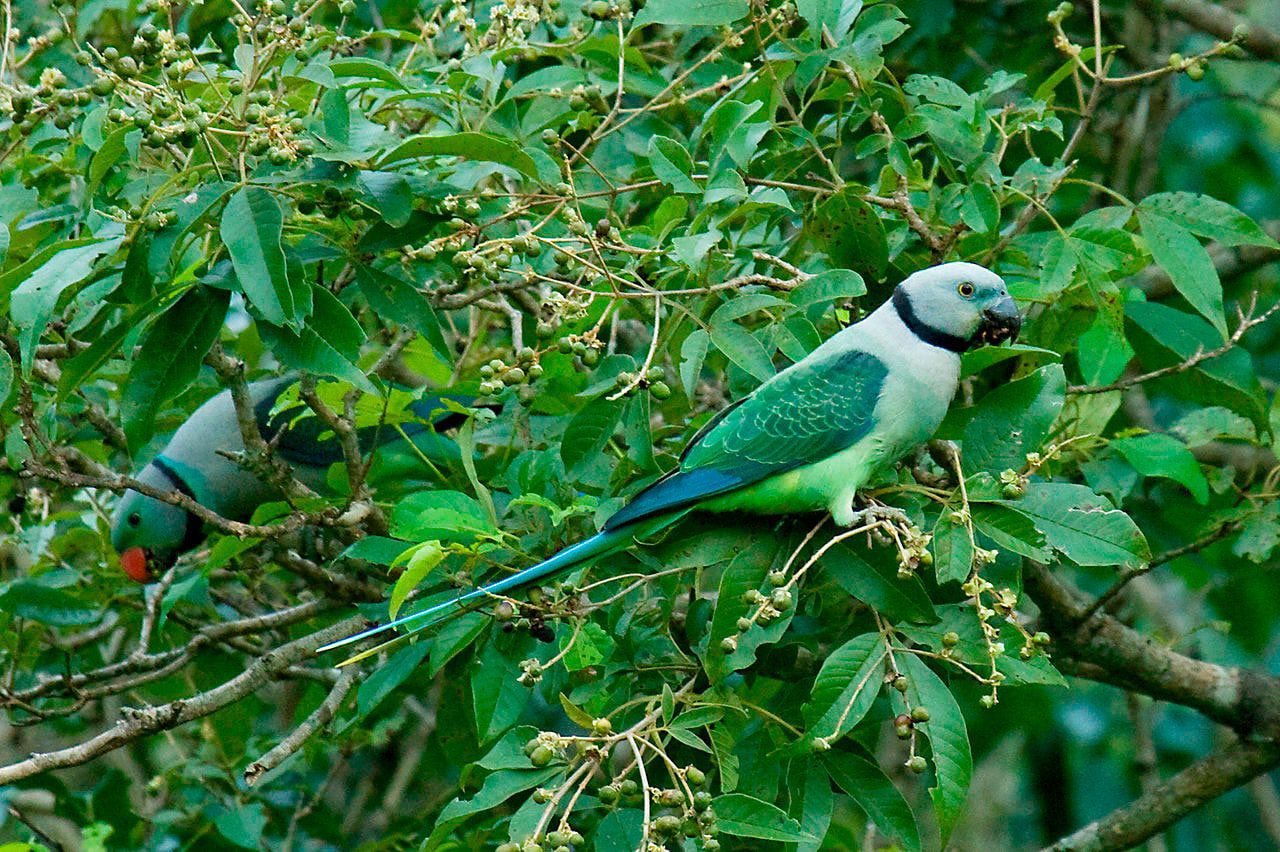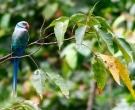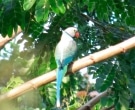Content |
|---|
Description:
Of 36 to 38 cm.. length.
The Malabar Parakeet (Psittacula columboides) has the lores and upper cheeks of green grass, blue tinge on the edges and in the dark pearl gray crown, the lower cheeks, the sides and rear of the neck; with wide black bands at the mustache that attenuate to form a collar black, then bordered with a band of bright blue-green, which extends around the throat.
Mantle dove-grey fading to greyish-green on back and scapulars; rump and uppertail-coverts pale bluish green, sides rump yellowish.
Lesser coverts dark green, subterminally tipped dark grey edged buffish; inner median coverts green with pale buffish margins; alula and greater coverts blue. The primaries and secondaries blue, darker in the vane inner. Underwing-coverts bluish green. Throat bright blue green; yellowish blue discoloration in the rest of the underparts; dove-grey in the chest; blue tinge on the thighs. Uppertail centrally bright blue, tipped yellow, lateral feathers greenish-blue on vane outer, in bright yellow inner; undertail-coverts bright golden-yellow centrally, otherwise brown with yellow tip.
upper jaw bright red with yellow tip, the lower brown, turning orange in the chin; irises light yellow; legs greenish-grey.
The female smaller, with little or no green in face and with both brown jaws. Underparts greyish-yellow. Less grey in the the mantle and tail shorter.
The immature shows grayish green in place of grey-plumage of adults. Collar black and green absent band neck.
- Sound of the Malabar Parakeet.
Habitat:
To a large degree, the Malabar Parakeet It is confined in forests (primary and secondary) evergreen upland, although according to sources, also observed in other formations, including deciduous forest adjacent to bamboo and especially in plantations coffee and rubber abandoned, and often close to small areas of crops.
Partly inhabit between 450-1.000 m, but exceptionally above 1.600 m, and up to about 60 m.
Usually, observed in family groups or small flocks.
At lower altitudes it is associated with Plum-headed Parakeet (Psittacula cyanocephala), completely replacing it at higher altitudes and in humid forests.
Reproduction:
Escavan their nests on branches or trunks, at a height between 6 and 30 m, sometimes they take advantage of the holes made by woodpeckers or Barbs, expanding the cavity. Los Ceylon ironwood (Mesua iron) are his favorite trees.
Usual clutch 4 eggs.
The breeding season It is between the months of January to March
Food:
Diet Malabar Parakeet It includes seeds and fruits, especially wild figs; regularly eat sprouts, flowers and nectar Erythrina and Grevillea.
They can be very destructive in crops of sorghum and fruit.
Distribution:
The Malabar Parakeet It is distributed by Ghats occidentales, India, on a narrow strip parallel to the west coast, from Pune (19 ° N), Maharashtra, through Karnataka, until Kerala and Tamil Nadu at 8° 27'N in the south.
Usually residents, but some nomadic movements They occur in response to the availability of food.
Conservation:
State of conservation ⓘ |
||
|---|---|---|
 Minor Concern ⓘ
(UICN)ⓘ
Minor Concern ⓘ
(UICN)ⓘ
| ||
• Current Red List of UICN: Least concern
• Population trend: Stable
The size of the world's population has not been quantified, but the species, according to information, It common throughout the core of its range (pit et to the. 1997).
The population is suspected to be stable in the absence of evidence of any reduction or substantial threats.
The bird trade and loss of habitat have caused, apparently, a decrease in its population, However, It is not sufficient to place this species at risk.
"Malabar Parakeet" in captivity:
The Malabar Parakeet it is rare in the pet trade.
This species was the subject of extensive trade, but now it is illegal in India. He was known in the pet trade as “Loro nonsense” and he gained a deceptive reputation as a top talker.
It is a parrot medium-noisy, occasionally noisy; initially shy; It becomes slowly confianda; newly imported birds are very likely; Care must be acclimatised; only it becomes active in a wide aviary; a common aviary with other species of Psittacula only possible outside the breeding season; little bathing but enjoys flying light rain outside; He likes to chop fresh branches; times aggressive during courtship; sensitive to cold and wet conditions.
Pet food variety, including aerosols millet, fruit, vegetables, Sunflower seed mixtures, oats and millet.
Rarely achieved the captive breeding; clutch 3 to 4 eggs; 23 incubation days; incipient period 6 weeks; young independent after 21 days; the calf sometimes aggressive with its mother.
In terms of their longevity, It is known that a Malabar Parakeet lived during 11,2 years in captivity.Given the longevity of similar species, This longevity is probably underestimated for these birds.
Alternative names:
– Malabar Parakeet, Blue-winged Parakeet (English).
– Perruche de Malabar (French).
– Taubensittich (German).
– Periquito-de-malabar (Portuguese).
– Cotorra de Malabar (español).
scientific classification:
– Order: Psittaciformes
– Family: Psittaculidae
– Genus: Psittacula
– Scientific name: Psittacula columboides
– Citation: (Vigors, 1830)
– Protonimo: Palaeornis columboides
Malabar Parakeet Images:
Videos "Malabar Parakeet"
Malabar Parakeet (Psittacula columboides)
Sources:
– Avibase
– Parrots of the World – Forshaw Joseph M
– Parrots A Guide to the Parrots of the World – Tony Juniper & Mike Parr
– Birdlife
– Photos:
(1) – Blue-winged Parakeet or Malabar Parakeet (Psittacula columboides) pair N. A. Naseer / www.nilgirimarten.com / naseerart@gmail.com [CC BY-SA 2.5 in], via Wikimedia Commons
(2) – Malabar Parakeet (Psittacula columboides). A male at Thattekad, Kerala, India By Lip Kee Yap [CC BY-SA 2.0], via Wikimedia Commons
(3) – Malabar Parakeet – Endemic to the Western Ghats By Suriyakumars (Own work) [CC BY-SA 3.0], via Wikimedia Commons
(4) – The Blue-winged Parakeet By Mailamal (Own work) [CC BY-SA 3.0], via Wikimedia Commons
(5) – Malabar Parakeet or Blue-winged Parakeet (Psittacula columboides) By Joseph Lazer (Personal Collection) [CC BY-SA 2.5 in], via Wikimedia Commons
(6) – A painting of a Malabar Parakeet, also known as the Blue-winged Parakeet, (originally captioned “Palaeornis columboides. Pigeon Parrakeet.”) by Edward Lear 1812-1888 [Public domain], via Wikimedia Commons
– Sounds: Sudipto Roy (Xeno-canto)






